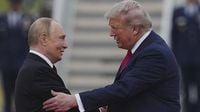On the heels of a high-profile summit in Alaska this August between U.S. President Donald Trump and Russian President Vladimir Putin, the prospect of peace in Ukraine appears increasingly elusive. Despite public displays of diplomacy and mutual praise, the realities on the ground and in the air suggest a deepening crisis, with civilians—especially children—bearing the brunt of the ongoing war.
Just a month and a half after the Alaska summit, Kremlin spokesman Dmitry Peskov remarked that the world remains “far from peace,” echoing a sentiment that has only intensified as Russian forces make steady advances in Ukraine. According to Peskov, European nations are encouraging Ukraine to abandon negotiations, fueling the ongoing conflict with Russia. Meanwhile, the United States is now openly discussing the possibility of direct involvement in strikes deep inside Russian territory, a move that would mark a dramatic escalation between the world’s two largest nuclear powers, as reported by multiple sources including Reuters and AP.
The summit itself, held in Alaska in August 2025, was lauded by both leaders as productive. President Putin, in particular, praised Trump’s ability to listen. “We only discuss the Ukrainian crisis, how to solve it,” Putin said after the meeting, as reported by Investing.com. He added, “The attempt to seek ways to solve the Ukrainian crisis is not bad.” Both leaders agreed to keep diplomatic channels open, with Putin expressing readiness to continue discussions on Ukraine. Trump, for his part, said, “I will say that I believe we had a very productive meeting. There were many, many points that we agreed on, most of them, I would say, a couple of big ones that we haven’t quite gotten there, but we’ve made some headway. So there’s no deal until there’s a deal.”
Yet, the aftermath of the summit tells a different story. Since August, Russia has intensified its military campaign, launching waves of drone and missile attacks across Ukraine. According to UNICEF, more than 3,500 schools have been assaulted by Russian drones, missiles, and cluster munitions since the war began in February 2022. The toll on children is staggering: estimates suggest that between 500 and 2,000 Ukrainian children have been killed, with thousands more injured. An additional 2,193 children are missing, and about 16 Ukrainian schoolchildren are killed or wounded every week. UNICEF’s regional director for Europe and Central Asia, Regina De Dominicis, stated in July, “There is no respite from the war for children across Ukraine. The situation for children is at a critical juncture, as intense attacks continue to not only destroy lives but disrupt every aspect of childhood.”
The violence has escalated since the summit, with Russian forces targeting residential buildings and even a central Kyiv kindergarten, killing 23 people—including four children—in one particularly deadly strike. The past week alone saw a 12-hour barrage of missiles and drones pounding Ukrainian cities, including attacks on government buildings and an American-owned factory in western Ukraine, according to Howey Politics Indiana.
Beyond the immediate human cost, the conflict has seen more than 19,000 Ukrainian children deported to Russia, with only 1,236 returned, according to the Yale Humanitarian Research Lab. The true number of children still in Russia is likely much higher. The United Nations Human Rights Monitoring Mission in Ukraine reported a more than 200% increase in verified child casualties between March and May 2025 compared to the previous quarter.
In the geopolitical arena, Putin continues to frame the war as a watershed moment in Russia’s relationship with the West. He accuses NATO of humiliating Russia after the Soviet Union’s collapse by expanding into what he considers Moscow’s sphere of influence, including Ukraine and Georgia. Western leaders, including former U.S. President Joe Biden and European heads of state, have repeatedly vowed to defeat Russian forces, portraying the war as an imperial land grab.
The military front is just as tense. Russian drones and aircraft have repeatedly violated NATO airspace in Poland, Estonia, Romania, Denmark, and Germany in recent weeks. European defense ministers have responded by agreeing to develop a “drone wall” along their borders to detect and intercept such incursions. Former NATO Supreme Commander James G. Stavridis, writing for Bloomberg, characterized these repeated airspace violations as “enemy action.” Putin, however, dismisses Western allegations of Russian aggression as “nonsense” and distractions from domestic problems, insisting that Russia is merely responding to the growing militarization of Europe.
Adding to the volatility, Putin recently warned that the potential supply of U.S. Tomahawk cruise missiles to Ukraine would mark a “qualitatively new stage of escalation, including in relations between Russia and the U.S.” He insisted, though, that such weapons would not change the balance on the battlefield, as Russian air defenses would quickly adapt. “We are fighting against the entire bloc of NATO and we keep moving, keep advancing and feel confident,” Putin stated, mocking the notion that Russia is a “paper tiger.”
Despite the saber-rattling, Putin reaffirmed his willingness to extend the New START nuclear arms control treaty for one more year past its February 2026 expiration, a move he framed as a gesture of goodwill. “If they don’t need it, we don’t need it either,” he said, but quickly added, “we feel confident about our nuclear shield.”
Meanwhile, U.S. support for Ukraine has been criticized as inconsistent and underwhelming. Trump’s post-summit rhetoric—wishing both countries well and expressing a willingness to continue supplying weapons to NATO—has been interpreted by some as a lack of resolve. Senator Lindsey Graham, along with more than 80 Senate co-sponsors, has introduced legislation to impose further economic sanctions on Russia, arguing that a firmer response is needed to bring Putin to the negotiating table.
The stakes extend beyond military and diplomatic maneuvering. The war’s impact on global markets has also been felt, with Putin warning Western allies against seizing ships carrying Russian oil, calling such actions piracy and threatening a forceful response that could destabilize the world oil market.
As the conflict grinds on, the gulf between diplomatic gestures and battlefield realities only widens. While dialogue channels remain open and leaders express hope for peace, the facts on the ground—especially for Ukraine’s children—paint a grim picture of a war with no end in sight.

